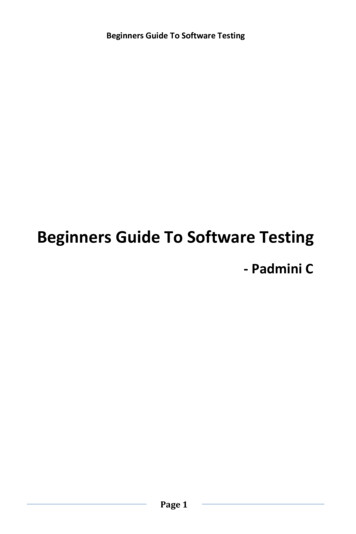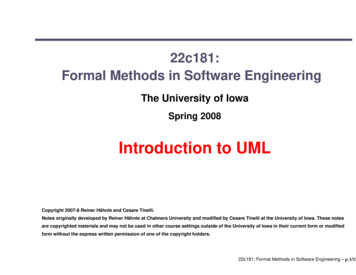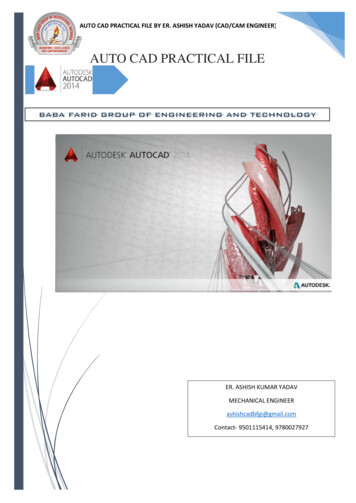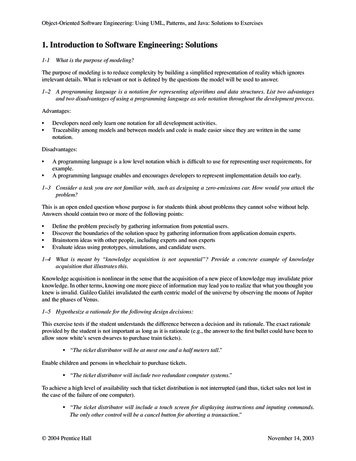
Transcription
Object-Oriented Software Engineering: Using UML, Patterns, and Java: Solutions to Exercises1. Introduction to Software Engineering: Solutions1-1What is the purpose of modeling?The purpose of modeling is to reduce complexity by building a simplified representation of reality which ignoresirrelevant details. What is relevant or not is defined by the questions the model will be used to answer.1–2 A programming language is a notation for representing algorithms and data structures. List two advantagesand two disadvantages of using a programming language as sole notation throughout the development process.Advantages: Developers need only learn one notation for all development activities.Traceability among models and between models and code is made easier since they are written in the samenotation.Disadvantages: A programming language is a low level notation which is difficult to use for representing user requirements, forexample.A programming language enables and encourages developers to represent implementation details too early.1–3 Consider a task you are not familiar with, such as designing a zero-emissions car. How would you attack theproblem?This is an open ended question whose purpose is for students think about problems they cannot solve without help.Answers should contain two or more of the following points: Define the problem precisely by gathering information from potential users.Discover the boundaries of the solution space by gathering information from application domain experts.Brainstorm ideas with other people, including experts and non expertsEvaluate ideas using prototypes, simulations, and candidate users.1–4 What is meant by “knowledge acquisition is not sequential”? Provide a concrete example of knowledgeacquisition that illustrates this.Knowledge acquisition is nonlinear in the sense that the acquisition of a new piece of knowledge may invalidate priorknowledge. In other terms, knowing one more piece of information may lead you to realize that what you thought youknew is invalid. Galileo Galilei invalidated the earth centric model of the universe by observing the moons of Jupiterand the phases of Venus.1–5 Hypothesize a rationale for the following design decisions:This exercise tests if the student understands the difference between a decision and its rationale. The exact rationaleprovided by the student is not important as long as it is rationale (e.g., the answer to the first bullet could have been toallow snow white’s seven dwarves to purchase train tickets). “The ticket distributor will be at most one and a half meters tall.”Enable children and persons in wheelchair to purchase tickets. “The ticket distributor will include two redundant computer systems.”To achieve a high level of availability such that ticket distribution is not interrupted (and thus, ticket sales not lost inthe case of the failure of one computer). “The ticket distributor will include a touch screen for displaying instructions and inputing commands.The only other control will be a cancel button for aborting a transaction.” 2004 Prentice HallNovember 14, 2003
Object-Oriented Software Engineering: Using UML, Patterns, and Java: Solutions to ExercisesEnable substantial modifications to the interface (e.g., increase the number of tariff zones or the number of products)without changes to the hardware.1–6 Specify which of the following statements are functional requirements and which are nonfunctionalrequirements: “The ticket distributor must enable a traveler to buy weekly passes.” “The ticket distributor must be written in Java.” “The ticket distributor must be easy to use.”The first requirement is functional, the third is nonfunctional. Using the definitions in Chapter 1, the secondrequirement is nonfunctional. In Chapter 4, we will call this requirement a pseudo requirement as it constrains aspectsof the system that are not visible to the user.1–7 Specify which of the following decisions were made during requirements or system design: “The ticket distributor is composed of a user interface subsystem, a subsystem for computing tariff, and anetwork subsystem managing communication with the central computer.” “The ticket distributor will use PowerPC processor chips.” “The ticket distributor provides the traveler with an on-line help.”The first decision is a system design decision. The second decision is also a system design decision if made bydevelopers (otherwise, it is a requirements decision). The third decision is a requirements decision.1–8 In the following description, explain when the term account is used as an application domain concept and whenas a solution domain concept:“Assume you are developing an online system for managing bank accounts for mobile customers. A majordesign issue is how to provide access to the accounts when the customer cannot establish an online connection.One proposal is that accounts are made available on the mobile computer, even if the server is not up. In thiscase, the accounts show the amounts from the last connected session.”The first two occurrences of “account” are application domain concepts while the last two occurrences are solutiondomain concepts. The phrases “accounts are made available on the mobile computer” and “the accounts show theamounts from the last connected session” denote a solution domain concept that gives users the illusion that they areaccessing their bank accounts on their mobile computer. However, the actual bank account is not on the mobilecomputer.1–9 What is the difference between a task and an activity?An activity is composed of a number of tasks. Both represent work, but tasks cannot conveniently be decomposed anyfurther.1–10 A passenger aircraft is composed of several millions of individual parts and requires thousands of persons toassemble. A four-lane highway bridge is another example of complexity. The first version of Word for Windows,a word processor released by Microsoft in November 1989, required 55 person-years, resulted into 249,000lines of source code, and was delivered 4 years late. Aircraft and highway bridges are usually delivered on timeand below budget, whereas software is often not. Discuss what are, in your opinion, the differences betweendeveloping an aircraft, a bridge, and a word processor, which would cause this situation.This is an open question whose purpose is to have students realize that software systems are not the only complexsystems out there. Answers should include two or more of the following points: To estimate the budget and schedule for a new bridge or aircraft, engineers use actual data from previous bridgesand aircraft. Word for Windows was an innovative piece of software with few or no precedents.Many bridges and aircraft are simply refinements of other existing artifacts. This reduces the proportion of theoverall effort that is dedicated to design (which is the most difficult to estimate).Bridges and aircraft are often associated with severe financial penalties when late or over budget. 2004 Prentice HallNovember 14, 2003
Object-Oriented Software Engineering: Using UML, Patterns, and Java: Solutions to Exercises Bridges and aircraft have safety requirements associated with them. This leads to a conservative approach todevelopment including the use of mature technologies and well defined processes.Bridges and aircraft are sometimes delivered late too. 2004 Prentice HallNovember 14, 2003
Object-Oriented Software Engineering: Using UML, Patterns, and Java: Solutions to Exercises 2004 Prentice HallNovember 14, 2003
Object-Oriented Software Engineering: Using UML, Patterns, and Java: Solutions to Exercises2. Modeling with UML: Solutions2-1Consider an ATM system. Identify at least three different actors that interact with this system.An actor is any entity (user or system) that interacts with the system of interest. For an ATM, this includes: Bank CustomerATM MaintainerCentral Bank ComputerThiefThe last actor is often referred to as a “misactor” in the literature, because it is an actor that interacts with the systembut shouldn’t.2–2 Can the system under consideration be represented as an actor? Justify your answer.The system under consideration is not external to the system and shouldn’t be represented as an actor. There are a fewcases, however, when representing the system as an actor may clarify the use case model. These include situationswhere the system initiates uses cases, for example, as time passes (Check for Outdated Articles, Send DailyNewsletter).2–3 What is the difference between a scenario and a use case? When do you use each construct?A scenario is an actual sequence of interactions (i.e., an instance) describing one specific situation; a use case is ageneral sequence of interactions (i.e., a class) describing all possible scenarios associated with a situation. Scenariosare used as examples and for clarifying details with the client. Use cases are used as complete descriptions to specifya user task or a set of related system features.2–4 Draw a use case diagram for a ticket distributor for a train system. The system includes two actors: a traveler,who purchases different types of tickets, and a central computer system, which maintains a reference databasefor the tariff. Use cases should include: BuyOneWayTicket, BuyWeeklyCard, BuyMonthlyCard, UpdateTariff.Also include the following exceptional cases: Time-Out (i.e., traveler took too long to insert the right amount),TransactionAborted (i.e., traveler selected the cancel button without completing the transaction),DistributorOutOfChange, and DistributorOutOfPaper.BuyOneWayTicketTime-Out extend extend onAborted extend CentralComputerSystemFigure fDistributorOutOfPaperExample solution to Exercise 2–4. 2004 Prentice HallNovember 14, 2003
Object-Oriented Software Engineering: Using UML, Patterns, and Java: Solutions to ExercisesThis questions can have several correct answers, Figure 2-1 being a possible answer. The following elements shouldbe present: The relationship between an actor and a use case is a communication relationship (undirected solid line).The relationship between exceptional use cases and common use cases is an extend relationship.The exceptional use cases described in the exercise only apply to the use cases invoked by the traveler.The following elements should be present in a “good” answer: All exceptions apply to all traveler use cases. Instead of drawing 3x4 relationships between these use cases, anabstract use case from which the exceptional use case inherit can be used, thus reducing the number of extend relationships to 3 at the cost of introducing 4 generalization relationships.The student can introduce exceptional use cases not specified in the exercise that apply to theCentralComputerSystem use cases.2–5 Write the flow of events and specify all fields for the use case UpdateTariff that you drew in Exercise 2–4. Donot forget to specify any relationships.Figure 2-2 depicts a possible solution for this exercise.Use case nameUpdateTariffParticipating actor Initiated by CentralComputerSystemFlow of events1. The CentralComputerSystem activates the “UpdateTariff” function of the ticket distributors availableon the network.2. The ticket distributor disables the traveler interface and posts a sign indicatingthat the ticket distributor is under maintenance.3. The ticket distributor waits for the new database from theCentralComputerSystem.4. After waiting a minute for the ticket distributors to reach a waiting state, the CentralComputerSystembroadcasts the new database.5. The ticket distributor system receives the new database of tariff. Upon complete,the ticket distributor sends an acknowledgement to the CentralComputerSystem.6. After acknowledgment, the ticket distributor enables the traveler interface andcan issue tickets at the new tariff.7. The CentralComputerSystem checks if all ticket distributors have acknowledged the new database. Ifnot, the CentralComputerSystem invokes the CheckNonRespondingDistributors use case.Entry condition The ticket distributor is connected to a network reachable by the CentralComputerSystem.Exit condition The ticket distributor can issue tickets under the new tariff, ORThe ticket distributor is disabled and displays a sign denoting that it is under maintenance.Qualityrequirements The ticket distributor stays offline at most 2 minutes and is considered out-of-order otherwise.Figure 2-2A possible solution for the UpdateTariff use case. 2004 Prentice HallNovember 14, 2003
Object-Oriented Software Engineering: Using UML, Patterns, and Java: Solutions to Exercises2–6 Draw a class diagram representing a book defined by the following statement: “A book is composed of anumber of parts, which in turn are composed of a number of chapters. Chapters are composed of sections.”Focus only on classes and relationships.Book1*Part1*Chapter1*SectionFigure 2-3Example solution for Exercise 2–6.This exercise checks the student’s understanding of basic aspects of class diagrams, including: Classes are represented with rectangles.The attribute and operations compartment can be omitted.Aggregation relationships are represented with diamonds.Class names start with a capital letter and are singular.2–7 Add multiplicity to the class diagram you produced in Exercise 2–6.See Figure 2-3. Aggregation does not imply multiplicity, thus the 1.* multiplicity is necessary.2–8 Draw an object diagram representing the first part of this book (i.e., Part I, Getting Started). Make sure that theobject diagram you draw is consistent with the class diagram of Exercise ure 2-4refs:SectionExample solution for Exercise 2–8.This exercise checks the student’s understanding of basic aspects of object diagrams, including: 2004 Prentice HallNovember 14, 2003
Object-Oriented Software Engineering: Using UML, Patterns, and Java: Solutions to Exercises Objects are represented with rectangles and underlined labels.The class of an object is included in the label of the object (e.g., uml:Chapter is of class Chapter).Links are represented with solid lines2–9 Extend the class diagram of Exercise 2–6 to include the following attributes: a book includes a publisher, publication date, and an ISBN a part includes a title and a number a chapter includes a title, a number, and an abstract a section includes a title and a :Integer[4]1Figure ringnumber:Integer*Example solution for Exercise 2–9.This exercises checks the student’s knowledge of attributes and their representation in UML (page 45).2–10 Consider the class diagram of Exercise 2–9. Note that the Part, Chapter, and Section classes all include a titleand a number attribute. Add an abstract class and a generalization relationship to factor out these twoattributes into the abstract ate:DateISBN:Integer[4]1Figure 2-6ChapterSectionabstract:String*1*1*Example solution for Exercise 2–10.This exercise checks the student’s knowledge of abstract classes and inheritance.2–11 Draw a class diagram representing the relationship between parents and children. Take into account that aperson can have both a parent and a child. Annotate associations with roles and multiplicities.Figure 2-7 depicts a canonical solution. This exercise is meant to emphasize the difference between a relationship, arole, and a class. In the above sentence, parent and child are roles while person is the class under consideration. Thisresults in a class diagram with a single class and a single association with both ends to the class. 2004 Prentice HallNovember 14, 2003
Object-Oriented Software Engineering: Using UML, Patterns, and Java: Solutions to ExercisesA common modeling mistake by novices is to draw two classes, one for the parent and one for the child.PersonparentFigure 2-7child*2Example solution for Exercise 2–11.2–12 Draw a class diagram for bibliographic references. Use the references in Appendix C, Bibliography, to testyour class diagram. Your class diagram should be as detailed as possible.The domain of bibliographic references is rich and complex. Consequently, students should deepened theirunderstanding of the domain before they attempt to draw a class diagram (similar to the requirements analysis of asystem). Figure 2-8 depicts an incomplete sample solution that could be accepted as sufficient from an instructor. Theclass diagram should minimally include the following concepts: An abstract class Publication (or BibliographicReference)A many to many relationship between Author and PublicationAt least three or more concrete classes refining PublicationAt least one aggregation relationship (e.g., between Journal and Article or Proceedings andConferencePaper). Both ends of the aggregation should also be subclasses of e e:IntegerExample solution for Exercise 2–12.2–13 Draw a sequence diagram for the warehouseOnFire scenario of Figure 2-15. Include the objects bob,john, FRIEND, and instances of other classes you may need. Draw only the first five message sends. 2004 Prentice Hallalice,November 14, 2003
Object-Oriented Software Engineering: Using UML, Patterns, and Java: Solutions to ExercisesThis exercise checks the student’s knowledge of sequence diagrams when using instances. This exercise can haveseveral correct answers. In addition to the UML rules on sequence diagrams, all correct sequence diagrams for thisexercise should include one or more actors on the left of the diagram who initiate the scenario, one or more objects inthe center of the diagram which represent the system, and a dispatcher actor on the right of the diagram who isnotified of the emergency. All actors and objects should be instances. Figure 2-9 depicts a possible answer.:FRIENDbobalicereportEmergency()new requestResource(fireTruck)commit()Figure 2-9notifyDispatcher()Example solution for Exercise 2–13.2–14 Draw a sequence diagram for the ReportIncident use case of Figure 2-14. Draw only the first five messagesends. Make sure it is consistent with the sequence diagram of Exercise 2–13.This exercise tests the student’s knowledge of sequence diagram when using classes. Like the previous exercise, thisexercise can have several correct solutions. A correct solution should include a FieldOfficer actor on the left, aDispatcher actor on the right, and one or more classes in the middle representing the FRIEND system. The answer tothis exercise should be consistent with the answer to the previous exercise, in the sense that all class and operationnames should be the same. Figure 2-10 depicts a possible answer.FRIENDFieldOfficerreportEmergency()new ent()*requestResource()commit()Figure 2-10notifyDispatcher()Example solution for Exercise 2–14.2–15 Consider the process of ordering a pizza over the phone. Draw an activity diagram representing each step ofthe process, from the moment you pick up the phone to the point where you start eating the pizza. Do notrepresent any exceptions. Include activities that others need to perform.Figure 2-11 is an example solution for this exercise. The following elements should be present in the solution: Activity names should be verb phrases indicating what the initiating actor is attempting to accomplish. Rolesshould be indicated with swimlanes 2004 Prentice HallNovember 14, 2003
Object-Oriented Software Engineering: Using UML, Patterns, and Java: Solutions to Exercises Activities that are concurrent or which do not need to happen in a sequential order should be indicated withcomplex transitions.2–16 Add exception handling to the activity diagram you developed in Exercise 2–15. Consider at least threeexceptions (e.g., delivery person wrote down wrong address, deliver person brings wrong pizza, store out ofanchovies).This exercise checks the student’s knowledge of decision points. Figure 2-12 depicts an example solution. Studentsmodeling a realistic example will also think about cascaded exceptions and learn to represent them with multipledecision points.2–17 Consider the software development activities which we described in Section 1.4. Draw an activity diagramdepicting these activities, assuming they are executed strictly sequentially. Draw a second activity diagramdepicting the same activities occurring incrementally (i.e., one part of the system is analyzed, designed,implemented, and tested completely before the next part of the system is developed). Draw a third activitydiagram depicting the same activities occurring concurrently.This exercise tests the student’s knowledge of the activity diagram syntax, not the knowledge of software engineeringactivities. In the sample solution provided in Figure 2-13, we assumed that requirements elicitation need to becompleted before any subsystem decomposition can be done. This leads to a splitting of the flow of control in thethird diagram where all remaining activities occur concurrently. The instructor could accept a solution whererequirements elicitation also occurs incrementally or concurrently with the other development activities. 2004 Prentice HallNovember 14, 2003
Object-Oriented Software Engineering: Using UML, Patterns, and Java: Solutions to ExercisesClientPizza ShopCallPizza ShopAsk foraddress&phoneAsk forpizza sizeAsk forpizza typeAsk fortoppingsPreparepizzaWait forpizzaDeliverpizzaReceivepizzaPayEatFigure 2-11 2004 Prentice HallAn example of pizza order activity diagram with exception handling.November 14, 2003
Object-Oriented Software Engineering: Using UML, Patterns, and Java: Solutions to ExercisesClientPizza ShopCallPizza ShopAsk foraddress&phoneAsk forpizza sizeAsk forpizza typeRevisetopping[cancel order]Ask fortoppings[no anchovies][proceed with order]PreparepizzaWait forpizzaDeliverpizza[wrong address]ReceivepizzaAsk correctaddressDeliver tonew address[wrong pizza][wrong address]TakelossPayEatFigure 2-12 2004 Prentice HallAn example of pizza order activity diagram.November 14, 2003
Object-Oriented Software Engineering: Using UML, Patterns, and Java: Solutions to ExercisesSequential ignObjectDesignImplementationAnalysis 1SystemDesign 1ObjectDesign 1Implementation1Analysis 2SystemDesign 2ObjectDesign 2Implementation2Analysis 3SystemDesign 3ObjectDesign 3Implementation3Analysis 1SystemDesign 1ObjectDesign 1Implementation1Analysis 2SystemDesign 2ObjectDesign 2Implementation2Analysis 3SystemDesign 3ObjectDesign 3Implementation3Incremental activitiesRequirementsElicitationConcurrent activitiesRequirementsElicitationFigure 2-13Example solution for Exercise 2–17. 2004 Prentice HallNovember 14, 2003
Object-Oriented Software Engineering: Using UML, Patterns, and Java: Solutions to Exercises3. Project Communication: Solutions3-1What is the difference between a role and a participant?A participant is an individual. A role corresponds to a set of responsibilities. A single participant can assume manyroles. Some roles may be shared among more than one participant.3–2 Can a role be shared between two or more participants? Why or why not?Some roles are assigned to more than one participant. For example, a team of developers can be assigned to the samesubsystem. Other roles, such as chief architect or project manager, can only be assigned to a single participant in theproject. In the end, the issue is one of assigning clear and non-overlapping tasks to single participants: When two ormore participants are responsible for exactly the same task, none of them will feel personally responsible for thesuccess of the task.3–3 What is the difference between a client and an end user?The client contracts the development of a system. The client is responsible for defining the scope of the system andfor financing the project. The end users are the participants who actually uses the system to accomplish their work. Insome project, the role of end user and client may be shared by the same participant. In general, however, this is not thecase.3–4 To which roles would you assign the following tasks? Change a subsystem interface to accommodate a new requirement. [system architect] Communicate the subsystem interface change to other teams. [API engineer (liaison)] Change the documentation as a result of the interface change. [editor] Design a test suite to find defects introduced by the change. [tester] Ensure that the change is completed on schedule. [project manager or team leader]3–5 You are responsible for coordinating the development of a system for processing credit applications for a bank.In what roles would the following project participants be able to contribute most to the project? a bank employee responsible for processing credit applications [end user] the manager of the information technology group at the bank, who contracted the system [client] a free-lancer who developed similar systems in the past [developer] a technical writer [editor]3–6 Draw a UML activity diagram representing the meeting process described in Section 3.4.3. Focus in particularon the work products generated before and after the meeting, such as the agenda and the meeting minutes. Useswimlanes to represent roles.Figure 3-1 depicts an example solution. This exercise tests the student’s knowledge of the meeting process and ofactivity diagrams described in Chapter 2.3–7 What is the difference between a work package and a work product?A work package is a description of work. A work product is the actual result of work (e.g., a document, a pieceof code, etc.).When is a work package defined?During planning.Consider an assignment where two students collaborate to plan and develop a system for sorting lists of namesusing two different sort algorithms. The deliverables for the assignment are the source code, the systemdocumentation, and a manual for other developers explaining how new sorting algorithms can be integratedinto the code. Give examples of work packages and work products in this project.Examples of work packages: Plan development 2004 Prentice HallNovember 14, 2003
Object-Oriented Software Engineering: Using UML, Patterns, and Java: Solutions to ExercisesFacilitatorMeeting ParticipantMinute TakerPost InitialAgendaReviewAgendaReviseAgendaAgree onAgendaFacilitateMeetingReport StatusItemsTake MeetingNotesEndMeetingDiscuss &Resolve IssuesReview ActionItemsPostMinutesFigure 3-1 An example meeting process (UML activity diagram).Define and document interface between system and sort algorithmsImplement algorithmsDocument systemExamples of work products: development plansource codesystem documentationmanual for explaining how to integrate new sorting algorithms3–8 What is the difference between a cross-functional team and a subsystem team? Provide examples and justifyyour choices. 2004 Prentice HallNovember 14, 2003
Object-Oriented Software Engineering: Using UML, Patterns, and Java: Solutions to ExercisesA subsystem team is completely responsible for the development of a subsystem.A cross-functional team is made outof liaison of subsystem teams and is responsible for support tasks, such as documentation and configurationmanagement. Also, the system architecture can is often defined by a cross-functional team made out of liaison fromall subsystem teams.3–9 As many critical communication events are planned (e.g., client reviews, project reviews, peer reviews), why isthere still a need for unplanned communication events (e.g., request for clarification, request for change, issueresolution)?There are many reasons for unplanned communication. Some of the more important ones are: Reduce latency: While developers could wait for the next project review to request clarification on their tasks oron interfaces provided by other teams, this would slow down development significantly and introduce muchrework (e.g., correcting code that was developed under incorrect assumptions).React to unexpected events: Any system of a realistic size cannot be completely specified and understood apriori. This results in requirements and design changes during development, which often have to becommunicated and negotiated among several stakeholders. While change processes can be set in place to managethis communication, much unplanned and informal communication complements the formal communicationevents to motivate, clarify, understand, gauge, and negotiate the underlying issues introduced by the change.Team building: Formal communication events are rarely conducive to a team atmosphere. It is during unplannedand informal events that participants get know each other and form a community working towards a commongoal.3–10 Select a random working day in your work week. Log all activities that qualify as communication activities(e.g., talking to friends over coffee, obtaining information from a fellow student, providing information,negotiating, advertising, browsing the web). Which fraction of your working day does commu
The first decision is a system design decision. The second decision is also a system design decision if made by developers (otherwise, it is a requirements decision). The third decision is a requirements decision. 1–8 In the following description, explain when the term
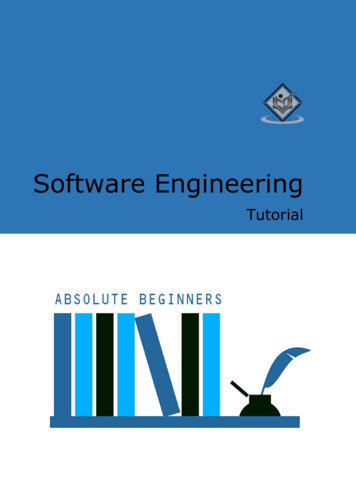

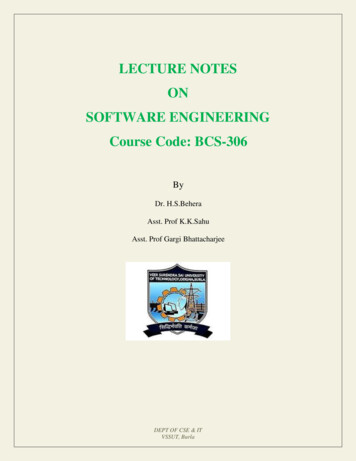
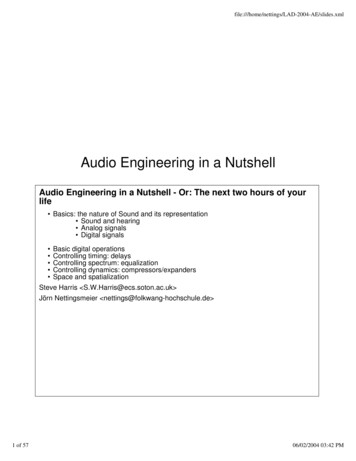

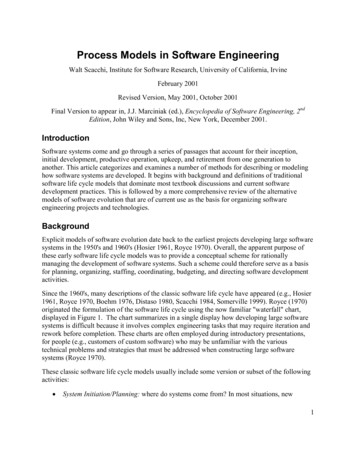
![Engineering Graphics Essentials [4th Edition]](/img/13/978-1-58503-610-3-1.jpg)
